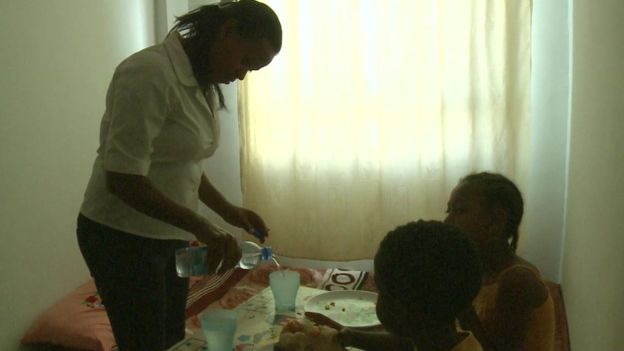Ethiopia has seen a massive cut in its fertility rate, from an average of seven children per woman in the 1990s to 4.6 currently. But how has it managed this? Experts say the country has made this turnaround because of a combination of factors.
“Women stay longer in school, the standard of living is increasing so people don’t want to have too many children and more importantly, family planning is becoming more popular,” explains Faustin Yao, the United Nation Population Fund (UNFPA) representative to Ethiopia.
The country’s economy is among the fastest growing in the world, and as the quality of life improves, people tend to have fewer children.
Muluwork Tesfaye, a nurse in Addis Ababa, says she could not afford to support a large family in the capital.
“My husband is the one who took me to college,” she says. “I wanted a better life for my children.”
In the capital, Addis Ababa, the fertility rate is estimated to be 1.7 – lower than the rate needed to keep the population steady.
More educated women and a higher cost of living often mean fertility rates are lower in urban areas.
Contraception
In Ethiopia, the availability of contraceptives has also played a big role.
“The increase in contraceptive use during 2000-2011 emerged as the single most important source for the recorded decline in TFR (Total Fertility Rate),” said a UNFPA report.
However, a quarter of all women who need contraceptives are still not able to get them.
Rural areas have also recorded a decline in the number of children per woman, albeit slower.
Ayenalem Daw, a mother of six living in Weyo Rafu Hargisa village about a four-hour-drive out of Addis Ababa, is in her late thirties.
She says if she had heard about family planning earlier, she would have had four children.
Most dangerous place to give birth:
Mandera – a vast, arid county on the north-eastern Kenyan tip bordering Somalia and Ethiopia – has one of the world’s highest fertility rates. On average, a woman there gives birth to eight children.
But it is also one of the world’s most dangerous places for a woman to give birth.
The UN Population Fund estimates that 3,795 women die giving birth out of every 100,000 live births. The national average is more than 10 times smaller.
Early marriage, female genital mutilation, low education levels especially for women, underdeveloped healthcare infrastructure contribute to the dire situation.
Local leaders are now keen on changing this trend by inviting foreign partners to invest in healthcare.
“Resources are everything,” said Mandera governor Ali Roba.
“We have a lot of competing interests; virtually every sector in Mandera is in dire need of attention.”
They are optimistic the rate will come down and when it does, so will the fertility rate.
ARAABINEWS.COM










More Stories
UK armed northern Somalia group start terrorising Las’anod town
Probe points to origin of drones used to attack Russia – media
Kadyrov says he is proud of EU sanctions against his daughters